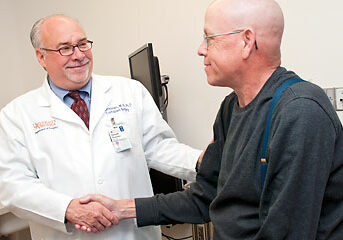No Aging Out: Older Kidneys Help Patients on Dialysis

Many people assume they can’t donate organs after they’ve reached a certain age, but science and research are disproving that notion.
Organs — especially kidneys – that come from senior citizens work well in many patients and they’re often far less risky than staying on dialysis.
New research indicates that organs from older donors have good outcomes in recipients and that an increase in older organ donors can do a lot to help shorten wait lists for organ transplants.
That premise makes sense since there are so many people waiting for transplants – especially kidney transplants, said Dr. Kenneth Brayman, transplant surgery division chief at the University of Virginia’s Health Sciences Center.
“Our outcomes are pretty fantastic using kidneys from higher KDPI donors,” Brayman said. “It just takes good management and good matching.”
Brayman explained that donor kidneys aren’t categorized by age. Instead, they’re given numerical ratings based on a number of factors, including the donor’s age, race and health. The Kidney Donor Profile Index, or KDPI, is a percentage based on all the factors and indicates the risk of kidney failure if that organ is used.
Calculating the risk
For example, the KDPI calculation may start with a 40-year-old white donor, 5 feet, 7 inches and 200 pounds with no diabetes, hepatitis or hypertension and perfect levels of serum creatinine (an indicator of kidney function). Assuming the donor died of an accident (as opposed to disease), the kidney has a KDPI of 22%, meaning that the estimated risk of failure from that donated kidney is higher than for 22% of all kidney donors in 2015.

Dr. Kenneth Brayman is the division chief of Transplant Surgery at UVA. Courtesy of UVA Health System.
That same scenario has a higher KDPI if the donor is older but it also has a higher KDPI if their weight or creatinine levels are higher. So an older donor in good health can have a better KDPI than a younger one with health issues.
Once a kidney has a KDPI rating, it’s up to the recipient and transplant center whether to accept it or not.
Based on the recipient’s condition and prognosis, a doctor may recommend that only a kidney with a low KDPI be accepted while a different patient could accept one with a higher KDPI.
A balancing act
It’s all a matter of balancing risk, Brayman said. Patients with kidney failure stay on dialysis until a kidney transplant is performed but dialysis has its own risks. Depending on the patient’s health and age, they may be better off taking a high KDPI kidney than staying on dialysis any longer.
That’s a matter for doctors and recipients to analyze and it’s different for each patient, Brayman said. The important thing is for potential donors not to take themselves out of the donor pool because they think they’re too old.
“The risk of staying on dialysis is often underestimated,” he said. The longer a patient is on dialysis, the higher the risk of death, and the risk of death is higher for older people on dialysis.”
So older patients are especially good candidates for high KDPI kidneys because they’re more likely to die on dialysis while they wait for a lower one.
The waiting list
That’s assuming a lower one becomes available at all. About 99,000 Americans were on the waiting list to receive a kidney in December 2016. Getting them lifesaving transplants is not just an issue of having enough kidneys, it’s also a question of allocating those that are available and that’s a process that’s improving with time.
“The KDPI rating was implemented in 2014 so we’re getting more experience with it now,” Brayman said.
One of the goals now is to expedite the allocation of high KDPI kidneys to high-risk recipients – which often means getting older kidneys to older patients so they can get off dialysis faster.
UVA doesn’t keep statistics on the age of donor kidneys but the facility is at the forefront of high-KDPI transplants, Brayman said.
Living donors always have to be in good health, but age alone is no reason why a donor – living or deceased – can’t save a life.
Thinking outside the box
The difference is due to the need to ensure good statistics. A transplant center that takes high-risk organs has a higher failure rate so many centers prefer to keep their success rate high by accepting only low-risk transplants.
UVA doesn’t do that, which means they are on the cutting edge of transplant medicine, but also that they could have regulatory problems if their statistics don’t look good enough.
That’s a national problem though, because it means there aren’t many transplant centers willing to adopt out-of-the-box methods or take high-KDPI kidneys.
To bridge the gap between caution and innovation, the U.S. Department of Health and Human Services has launched a three-year project called COIIN. The Collaborative Innovation and Improvement Network, which chose UVA for its pilot program, aims to increase transplantation, especially for kidneys with a KDPI of 50% or more.
The goal is to get more transplant centers to adopt UVA’s aggressive philosophy, in part by changing the way outcomes are measured. UVA’s Health Sciences Center was the only facility in the Mid-Atlantic chosen for Phase I of the COIIN project.
“Our outcomes are pretty fantastic using kidneys from higher KDPI donors,” Brayman said. “It just takes good management and good matching.”
Research and results
UVA’s practice of considering age as only one of many factors holds up, according to new study on donor age.
In the “Clinical Journal of the American Society of Nephrology,” lead author Dr. Luigi Biancone of the University of Torino in Italy, wrote that his team found similar survival rates for recipients of organs from donors 50-59 years old, 60-69 years old, 70-79 years old and 80 years and above.
The study concludes that older people can donate organs as long as the selection and allocation processes are good.
Living donors
While COIIN focuses primarily on high-KDPI kidneys from deceased donors, UVA is also having a lot of success with kidneys donated from older living donors.
Brayman said it makes sense for older people to donate kidneys to their loved ones – especially older loved ones. Losing (or donating) a kidney has long-term health risks that are muted when the donor is already a senior citizen. Living donors always have to be in good health, but age alone is no reason why a donor – living or deceased – can’t save a life.
